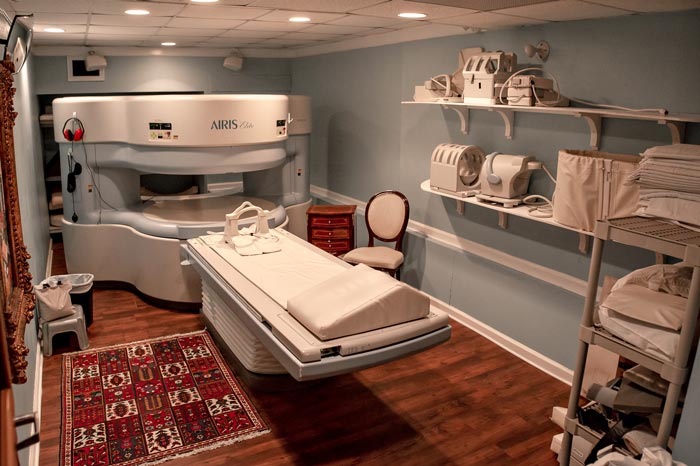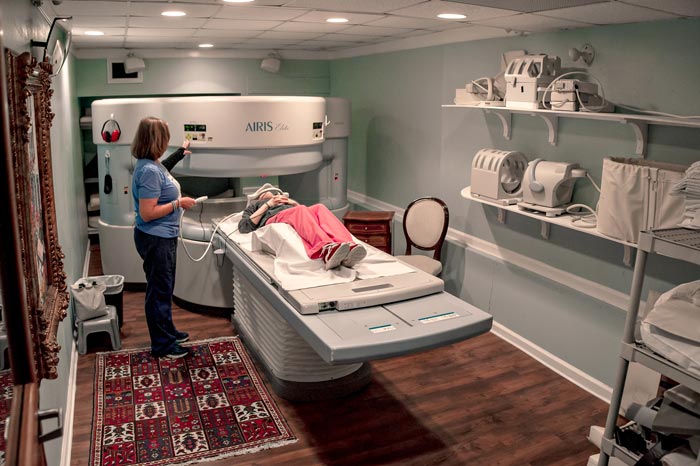Open-Field MRI
At High Tech Imaging Center, we are able to accommodate patients who are claustrophobic and overweight with our open MRI machine. If a patient is originally scheduled on our HIGH FIELD machine and they run into difficulties, we can relocate them in our open MRI machine to attempt the procedure more comfortable.
Conventional MRI scanners are a cylinder shape, while an open MRI does not completely surround your body. It is usually open on two or three sides. An open MRI provides a more relaxed, less confining environment and lowers noise levels making it less stressful for you.
Open MRI scanners offer a more comfortable experience for children, or for patients who are claustrophobic, obese or elderly.

Be Prepared
Preparation for Procedure
The presence of metal in or on your body is a safety hazard for an MRI exam. There are certain medical conditions that may prevent you from having an MRI exam.
You will be asked a series of medical history questions to determine whether you may proceed with the MRI exam. You will be asked to remove all metal or electronic objects from your body before the exam. These objects interfere with the magnetic field and can be very dangerous if taken into the exam room. If you have ever had metal in your eyes you may need to have an X-ray of your head prior to undergoing an MRI.
Tell your technologist at the time of your MRI scan if you have any metal or electronic devices in or on your body including, but not limited to:

- Watches or jewelry
- Cell phones or PDAs
- Implanted electronic devices
- Implanted metallic joint prostheses, artificial heart valves, cochlear implants, hearing aids or metallic dentures.
Tell your technologist and your doctor if you are pregnant or suspect you may be pregnant. Your doctor may postpone the exam or choose an alternative exam.
No preparation is necessary prior to your MRI exam.
Some patients may feel anxious due to the confining nature of the MRI scanner. If you feel this way, talk to your doctor. He or she may feel it necessary to prescribe a sedative prior to your MRI exam to help you relax.
Your doctor or radiologist may request that your MRI scan be enhanced via the use of contrast material. If contrast is required, the technologist will start an intravenous (IV) line in your hand or arm to administer the contrast.
Although rare, there is a slight risk of an allergic reaction to contrast material. Therefore, you will be asked a series of questions about your medical history to determine whether you may receive contrast.
Most reactions are minor such as itchiness, hives, and nausea or vomiting. In very rare instances, an allergic reaction may cause swelling in your throat or other areas of your body. Tell your technologist or doctor immediately if you experience any of these symptoms during or after your MRI scan.
Don’t be Surprised!
What to Expect During the Exam?
The MRI exam is painless and on average takes between 30 to 45 minutes, excluding preparation time. The amount of time varies depending on the type and number of exams for which you are scheduled.
During the MRI exam, you will be asked to lie on a movable table. A coil or small antenna-like device may be placed over the body part to be examined. Once you have been positioned the technologist will move the table into the MRI scanner which is a long tubular shaped machine.
During the MRI scan, the magnet produces repetitive thumping and tapping sounds. You will be given earplugs to help block the noise of the scanner. You will also have the option of listening to the music of your choice.
The technologist monitors you throughout the procedure. A microphone system enables you to communicate with the technologist at all times. You will also be given a device that will allow you to alert the technologist if you are having any difficulty during the procedure.
We Will Take Care of The Rest!
What About the Results?
When your exam is complete you may leave and resume regular activities. If a sedative is administered for your MRI scan you will need to arrange transportation home.
A radiologist will review your exam images and report the findings to your doctor within 24 hours. Your doctor will then discuss the findings and the next steps with you.
Advantages of MRI
Advantages of an Open Field MRI
The open MRI machine is a large magnet. When you lie inside the machine, the magnetic field temporarily aligns all the water molecules in your body. Radio waves cause these aligned particles to produce very faint signals, which are used to create cross-sectional images of your body — like slices in a loaf of bread. The MRI machine can combine these slices to produce 3-D images that may be viewed from many different angles.
Open MRI scanners offer a more comfortable experience for children, or for patients who are claustrophobic, obese or elderly.




